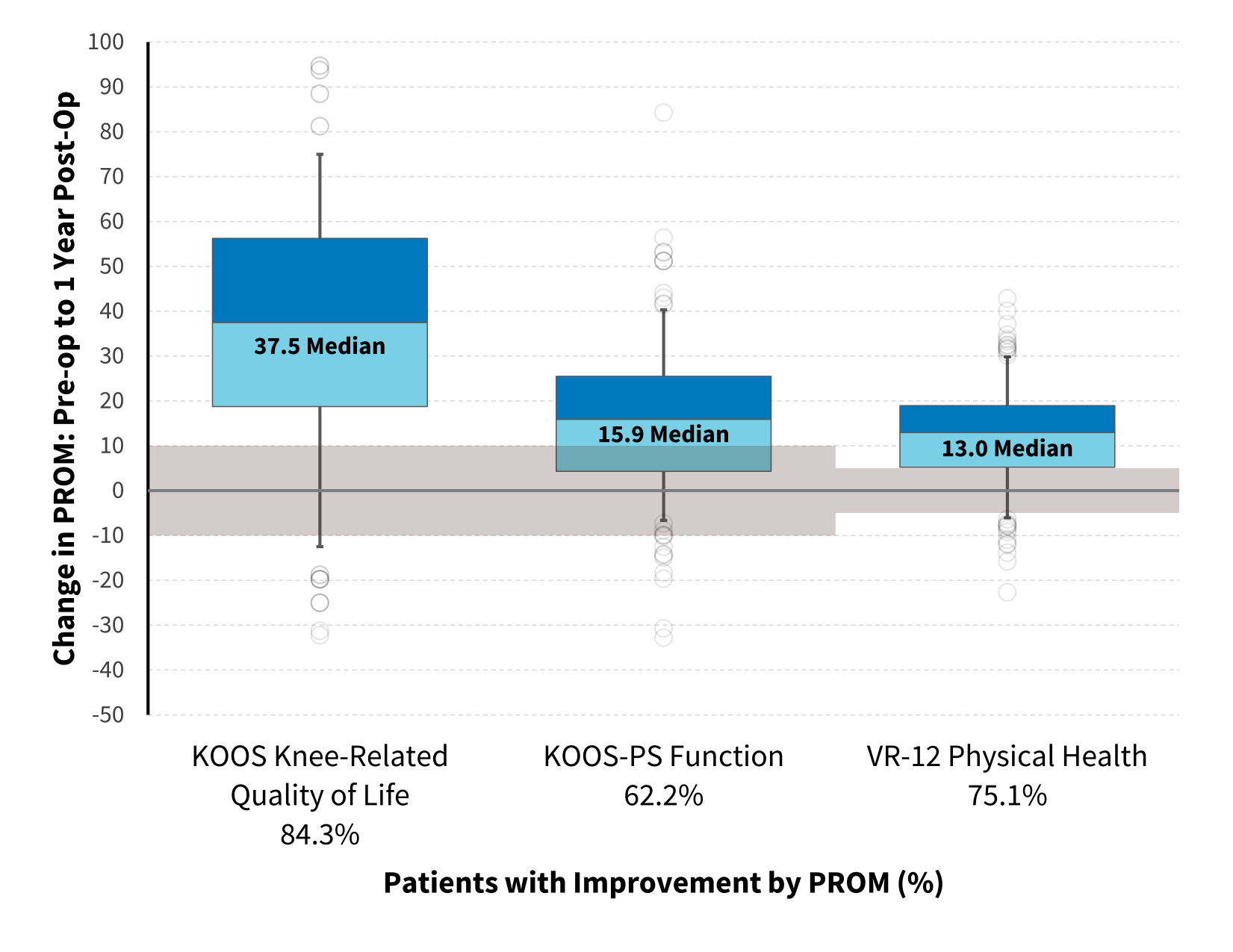Orthopaedic & Rheumatologic Institute Outcomes
Sports
Anterior Cruciate Ligament Reconstruction
Patient-Reported Outcome Measures 1 Year After Primary Unilateral Anterior Cruciate Ligament Reconstruction from the Prospective OME Cohort
2021-2022 (N = 467 , 53.4% follow-up)
In 2021, 23 distinct surgeons performed primary unilateral anterior cruciate ligament reconstruction (ACLR) surgery on 467 patients at specific sites where the prospective Cleveland Clinic OME Cohort was active. Of these patients, 94.9% completed patient-reported outcome measures (PROMs) at baseline and 53.4% followed up at 1 year. The average patient age was 26.9 years and 53% were male.
84.3% of patients experienced improvement in knee-related quality of life after one year with a median absolute improvement of 37.5 points. Knee-related quality of life was measured by the Knee injury and Osteoarthritis Outcome Score¹ (KOOS) KRQoL scale, which ranges from 0-100 points (higher scores indicate better knee-related quality of life) and has a minimal clinically important difference (MCID) of 10.0.
62.2% of patients experienced improvement in knee function with a median absolute improvement of 15.9 points. Knee function was measured by the Knee injury and Osteoarthritis Outcome Score Physical Function Shortform² (KOOS-PS) instrument, which ranges from 0-100 points (higher scores indicate better knee function) and has an MCID of 10.0.
75.1% of patients experienced improvement in overall physical health with a median absolute improvement of 13.0 points. Physical health was measured by the Veterans RAND 12-Item Health Survey³ (VR-12), which is a norm-based scale where 50 represents the mean score of a nonpatient control group and every 10 units represents 1 standard deviation from the mean. The MCID is estimated at 5.0.

The box plot illustrates patients' one-year outcomes with respect to three separate PROMs: knee-related quality of life, knee function, and overall physical health. Here, "improvement" means that the change in score from pre-op to post-op exceeds the MCID for a PROM and is represented by the shaded region around the horizontal axis. The center horizontal line of each box represents the median change in PROM score, while the boxed regions above and below the center line represent the middle 50% of patients. Error bars represent 95% of patients and circular bubbles represent outliers.
- Roos EM, Lohmander LS. The Knee injury and Osteoarthritis Outcome Score (KOOS): from joint injury to osteoarthritis. Health Qual Life Outcomes. 2003 Nov 3;1:64. doi: 10.1186/1477-7525-1-64.
- Perruccio AV, Stefan Lohmander L, Canizares M, Tennant A, Hawker GA, Conaghan PG, Roos EM, Jordan JM, Maillefert JF, Dougados M, Davis AM. The development of a short measure of physical function for knee OA KOOS-Physical Function Shortform (KOOS-PS) - an OARSI/OMERACT initiative. Osteoarthritis Cartilage. 2008 May;16(5):542-50. doi: 10.1016/j.joca.2007.12.014. Epub 2008 Feb 21.
- Kazis LE, Miller DR, Skinner KM, Lee A, Ren XS, Clark JA, Rogers WH, Spiro A 3rd, Selim A, Linzer M, Payne SM, Mansell D, Fincke RG. Patient-reported measures of health: The Veterans Health Study. J Ambul Care Manage. 2004 Jan-Mar;27(1):70-83.
